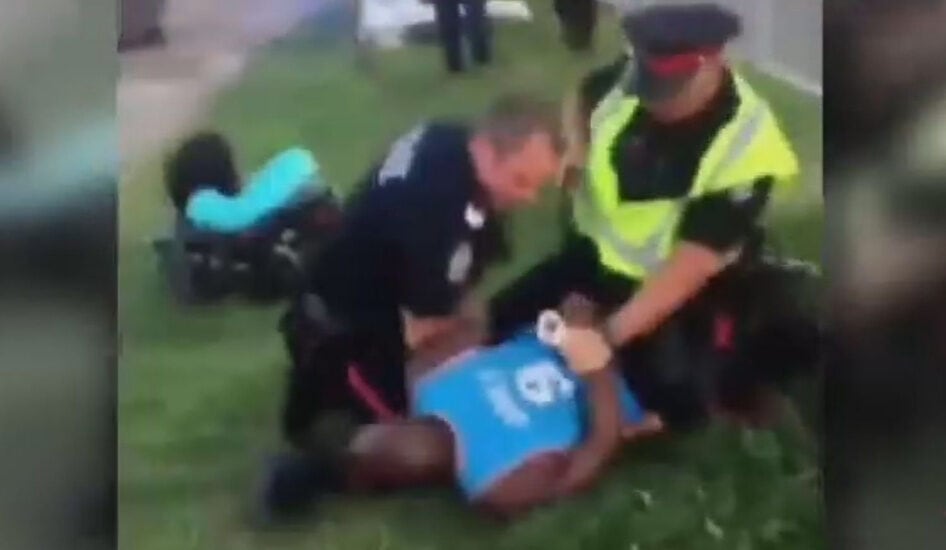
KJIPUKTUK (Halifax) – It’s nearly a year since George Floyd’s murder by Minneapolis policeman, Derek Chauvin. During this year there have been hundreds, if not thousands of demonstrations, pickets and marches around the world against reckless police brutality meted out to Black, Indigenous and racialized people.
We know that 30 minutes before the jury in the Floyd case rendered its guilty verdict for Chauvin, a 16-year-old honour roll student Ma’Khia Bryant was killed by a policeman. Bryant, who is Black, was shot four times by Nicholas Reardon, a white cop in Columbus, Ohio. Videotape released from police body cameras, shows Bryant, sporting her brightly tie-dyed Crocs, holding a steak knife in one hand, being shot in the back four times. Officer Reardon shot Bryant within 11 seconds of his arrival at the scene, a middle-class suburban street. Bryant had called 911 to ask for police help when a gaggle of bigger teens had come by to bully and threaten her. The video shows at least three cops on scene including one who was Black. After shooting Bryant, Reardon kept repeating “what do you need me to do?” again and again. One wonders whom he was asking.
The scene was painfully reminiscent of the June 2020 police murder of Chantel Moore of Edmunston, New Brunswick. Moore, a 26-year-old Indigenous mother of one, had recently moved from BC to Edmunston to be close to her five-year-old daughter who was living with her grandmother. Again a white cop pumped 5 bullets into Moore’s chest, because she was holding a kitchen knife. As in the Bryant case, the cops had received a phone call that night from Moore’s former boyfriend in Toronto. He asked them to go to her apartment to check on her in a “wellness check.” One rookie cop banged on Moore’s door after 2 a.m. After the atrocity, Canada’s minister of Indigenous Services, Marc Miller said he was “pissed” and “outraged”, “I don’t understand how someone dies during a wellness check.”
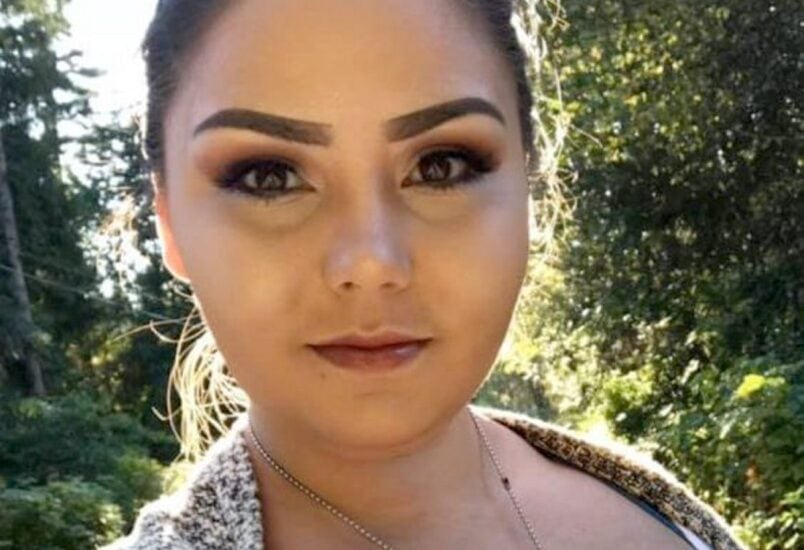
After the shooting, New Brunswick’s Dept of Justice and Safety asked Quebec’s police watchdog, BEI (Bureau des Enquetes Independantes)
A week after Moore’s death, another New Brunswick “wellness check” ended in police killing Rodney Levi, in Sunny Corner. Levi, was a 47 year old member of the Metepenagiag First Nation.
Suffering from depression and other mental health problems, at dinner time on June 12 he was at a friend’s for a BBQ. He took two knives from the kitchen and brandished them at the police, when they arrived just after being called. Earlier that day he had told a relative he wanted to die through “suicide by RCMP”. Police tasered him three times, and when he did not drop the knives, they shot him dead. The crown ruled out any charges, and despite Levi’s relatives’ request, there was no inquiry into his death.
In both Canadian cases, we see that it was Indigenous people who were gunned down in a home environment. Moore was no danger to herself or anyone else. Levi was confused and little danger to three trained police. It seems the use of force that is trained and practiced by the police – in Canada and in the US — shoot to kill, not just to maim.
The question is, why don’t the cops routinely use non-lethal force? Why is it that police departments and police unions in the US and especially in Canada are falling over each other to justify their use of lethal force?
While a typical source of legal force is use of a gun, another is kneeling on someone’s neck. I’m turning to that now.
We are all familiar with the nine minutes of torture which killed George Floyd, a Black man, in Minneapolis in June 2020. And there was rejoicing when his assassin, a white cop, was convicted on three counts including murder.
However here in Canada we have a murder case by cops kneeling on the neck that has recently been revealed in the TVO podcast Unascertained.
Item: Lindsay, Ont. – December 2016: Soleiman Faqiri, a 30 year-old-man who suffered from schizophrenia, lived with his parents in Ajax, Ont. In early December, Faqiri stabbed a woman who was an acquaintance; luckily, she survived. Police immediately took Faqiri to Central East Correctional Centre in Lindsay, Ont., known colloquially as the Lindsay Superjail. Once there, he was not permitted to see his family, or to make phone calls. Worse, he was locked in a segregation cell. He had no idea why he was in jail, or when he would be released. His family was desperate to help him but was turned away by prison officials. Faqiri refused to eat, upended his food trays and screamed.
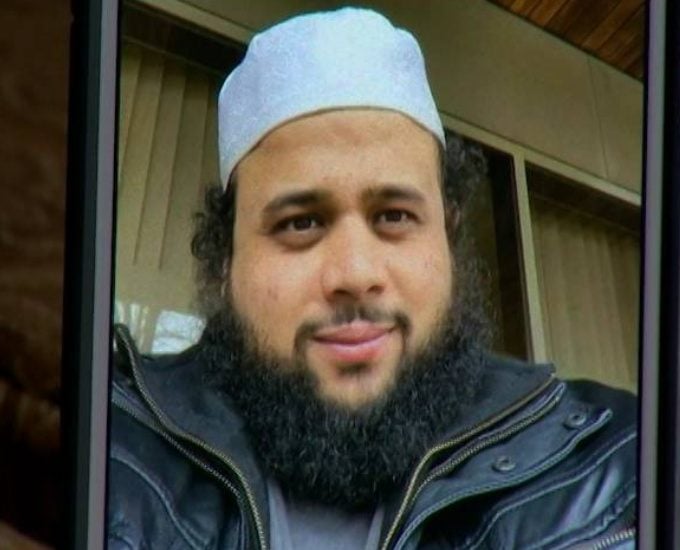
After 11 days in an isolation cell, jailers dragged him to the shower, to clean him up for transfer to a psychiatric facility. Faqiri refused to leave the shower. Half a dozen guards dragged him handcuffed back to his cell, and then started to beat him. This (of course) is disputed by the jail guards. But in the months following this incident, several of the guards were fired and the jail refuses to give a reason. While Faqiri’s hands were cuffed behind him, the guards deployed pepper spray, put a spit hood on his head and punched him dozens of times. Guards pushed him to the floor of his cell, and one guard knelt on his neck.
While cause of death was noted as “unascertained” – another prisoner witnessed the events of that day. Too afraid to speak while in jail, after his release John Thibeault, 32, agreed to an interview with a journalist. The former prisoner explained he was in the isolation cell directly across the hall from Faqiri. Through the tiny window in the cell door, Thibeault said he had never seen the guards react with that extreme violence toward a prisoner before. Thibeault, who had tried some friendly banter with Faqiri from his cell for a few days earlier, maintains that the guards killed Faqiri.
Within months of the killing, and before Thibeault could give his evidence, the Ontario Provincial Police (OPP) closed its investigation into Faqiri’s death.
This is not the only case of Canadian police kneeling on a suspect’s neck.
Item: Calgary, Alberta – December 2013: Gottfred Addail-Nyameky, who is Black, was driving friends home from a party in late December when his car got stuck in a snowbank. He does not drink and was the designated driver. Police happened by and refused to help push the car out of the snowbank. Addail-Nyamekye recalls that he was “lippy” to the cops for refusing to help. In response, they grabbed and cuffed Addai-Nyamekye and threw him in the back of the police van. They drove him to a deserted construction area on the outskirts of Calgary; he had no idea where he was. They removed the handcuffs and taunted him not to bother the police again.The police then tossed him out of the car. It was -28C and well after midnight. Addai-Nyamekye was wearing only a tracksuit, no gloves or winter coat. Fearing he was going to freeze to death alone, he phoned 911. Twice he was told not to phone again; then on a third try, he begged for police to help him. When the operator asked how the police would recognize him, he told her he was Black and, “Just because I’m Black doesn’t mean I’m bad.”
Calgary policeman Trevor Lindsay arrived. According to Addai-Nyamekye, Lindsay pushed him to the ground, then used his taser on Addai-Nyamekye twice, before punching in the head several times and kicking him. Lindsay also knelt on his neck more than once. Lindsay put Addai-Nyamekye in handcuffs and then dragged him and threw him down again.
“He told me to shut the fuck up, he was going to kill me,” Addai-Nyamekye testified at Lindsay’s sentencing hearing on aggravated assault . Addai-Nyamekye’s ordeal is the subject of a new documentary Above the Law on CBC-GEM.
Item: Fort McMurray, Alberta — March 2020: Allan Adam, Chief of Athabasca Chipewyan First Nation, was severely beaten and bloodied by an RCMP officer in the parking lot of the city’s casino. Police said Adam had an expired license plate on his truck. The police threatened him and his wife, when he went to his wife’s aid, he was set upon and tackled by RCMP officers, one of whom knelt on the back of his neck and kept punching his head. The cops then charged Adam with resisting arrest and assaulting a peace officer – charges that were dropped after Prime Minister Trudeau weighed in on national television to say he had “serious questions” about the RCMP arrest of Chief Adam. “The independent investigation must be transparent and be carried out so that we get answers.”
Item: La Ronge, Saskatchewan — December, 2020: Emily Kammermayer, a member of Lac La Ronge Indian Band, brought her son who had a swollen arm to see the doctor at the La Ronge Health Centre. She became angry when the doctor said her 2-year old son did not require an x-ray. She banged the door closed when she left the doctor’s office. The next thing she knew the RCMP had been called, and had cornered her at the Health Centre, and pushed her down on the floor.
“One of the officers placed their knee on my neck and it felt like I couldn’t breathe,” she said. In a statement she said, “There is never any reason to do that to somebody. To inflict that kind of pain on to someone…“To make someone struggle to grasp any air, to make someone feel that these might be their last moments.”
Kammermayer was cuffed at the wrists and ankles and the two restraints were bound together — “hog-tied,” she told the media. She said that she was further demeaned when she was told to “hop like a bunny” to the detention area at the detachment.
Item: Edmonton, Alberta, July 2018: an Edmonton police officer knelt on Jean-Claude Rukundo’s neck for four minutes according to his wife Sife Ngize. She filmed the take-down which took place when Rukundo refused to leave the scene of a car accident that involved his wife. Rukundo and Ngize are Black, from Africa. The cops charged Rukundo with obstruction, but dropped the charge when Ngize went public and launched an official complaint about the cops immobilizing her husband with a knee on his neck.The only offence the police officer was disciplined for was his use of profane language.
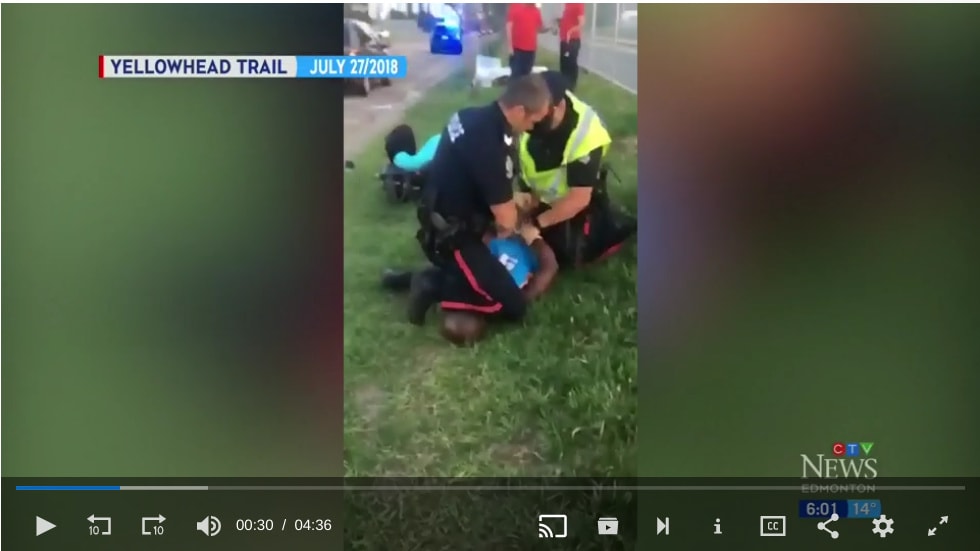
Edmonton police trainer Staff Sgt Terry Langley said EPS (Edmonton Police Service) officers are not trained to target a person’s neck or head when restraining them. But, he added, the positioning of the leg across the subject’s head was not any longer than about 40 seconds.”
Still, Langley’s comment was of little comfort to Rukundo who –during the interaction with police– feared for his life. He was the sole breadwinner for his family of five children.
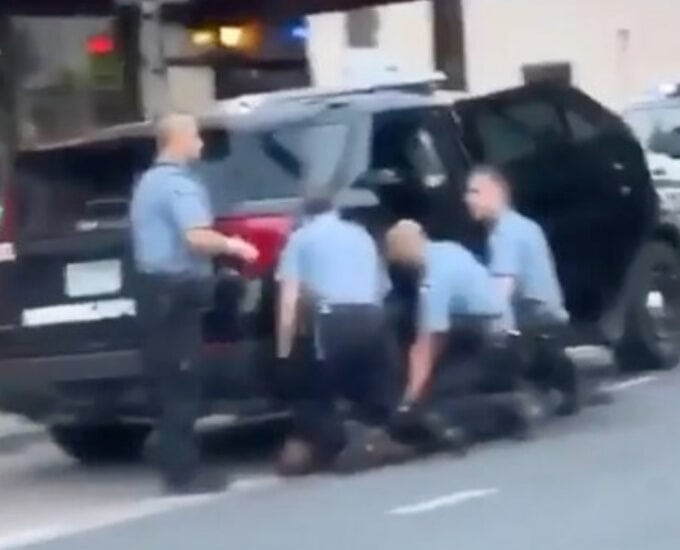
In June 2020, Toronto’s former chief of police, Mark Saunders talked about knee-to-neck restraint at a media conference ten days after the police killing of George Floyds. He said, “our organization does not train to this.”
The former chief of police for Moose Jaw, Sask. Terry Coleman said it was not ever “necessary” to use the tactic. He recommends time, patience and better communication skills.
However, the RCMP and countless other forces across Canada are still using the knee-on-the-neck to force compliance.
In the first three months of 2021, RCMP officers used the knee-to-neck hold (officially) 26 times. Between 2017 and 2021, injured victims of the hold had to be taken to hospital 12 times. As former Ottawa police officer Greg Brown, now a research professor at Carleton University, said about the police’s use of the ‘carotid hold’ in the field.“I was just always very nervous because when you’re compressing the blood flow to somebody’s brain at the side of their neck, very bad things can happen.”
However, in June 2020, during the massive protests against the murder of George Floyd, the RCMP denied it teaches or endorses any technique in which officers place a knee on a person’s head or neck.
“This applies to the teaching of cadets at the RCMP Academy, Depot Division, as well as in-service training and use-of-force re-certification,” Corporal Caroline Duval said in a statement.
But Duval seemed to get her wires crossed. In June 2020, Chief Commissioner Brenda Lucki announced there would be an RCMP review of the training and use of the “carotid control technique.” Lucki emphasized that during the review there would be no suspension of use of the hold. The review’s report should have been released at the end of 2020. Nearly six months later, no report has been released.
Still, the RCMP allowed that though the knee-on-the-neck can cause a brief period of unconsciousness, it allows the cops to safely handcuff a subject. And the National Police Federation, the union that represents more than 20,000 frontline RCMP officers, fully supports the use of this type of neck restraint.
They are not the only ones. The Canadian Police Research Centre’s 2007 report, The National Study on Neck Restraint in Policing, endorses the use of what it labels vascular neck restraint (VNR). This report finds that while no restraint methodology is completely risk free, there is no medical reason to routinely expect grievous bodily harm or death following the correct application of the vascular neck restraint in the general population by professional police officers with standardized training and technique.
Still, the medical doctor who authored the report warns that “maximal compression will likely result in involuntary compliance (unconsciousness) with 10-15 seconds (p. 78).
Not inclined to throw caution to the wind, the report’s authors wrote, “The use of VNR should be avoided, where possible, in the presence of the following visible risk groups (p. 77):
- The obvious elderly.
- Obvious pediatric subjects.
- Obvious or known Down’s syndrome (Trisomy 21)
- The obviously, visibly pregnant woman
Two things can be said about the practise of police applying their knees to the necks of “suspects”.
First, the technique is often applied to totally innocent people. When police arrive at a scene they demand control and compliance right off the bat. If anyone is upset, angry or not overly co-operative, and delays or gets in the way of what the police want — this technique is used.
Second: In Canada, knee on-the neck is likely mainly applied to Black and Indigenous people. The racialization of this form of torture can be seen in many cases in the US. And it’s no doubt more frequently used than most Canadians want to believe.
I’m interested in finding out if anyone who reads this has been subject to the knee-on-the-neck. Please write me at jhaiven@gmail.com
Check out our new community calendar!
With a special thanks to our generous donors who make publication of the Nova Scotia Advocate possible.
Subscribe to the Nova Scotia Advocate weekly digest and never miss an article again. It’s free!



